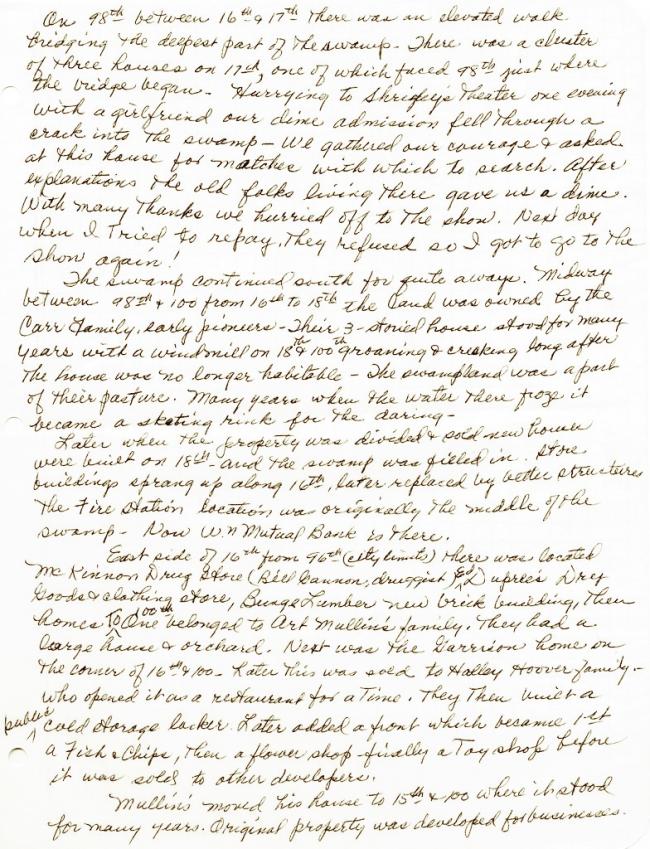Two shows for a dime in old White Center
These memories have been transcribed from Gertrude Finney's handwritten diary entries.
Mon, 10/11/2010
(Editor's Note: Jerry Robinson continues with the diary entries of 100-year-old Gertrude Finney as she recalls growing up in White Center.)
Diary 3
Between 98th & 100th was swampland. Also between 16th & 17th was swampland.
On 98th between 16th & 17th there was an elevated walk bridging the deepest part of the swamp. There was a cluster of three houses on 17th, one of which faced 98th just where the bridge began.
Hurrying to Shrigley's Theater one evening with a girlfriend, our dime admission fell through a crack into the swamp. We gathered our courage & asked at this house for matches with which to search. After explanations, the old folks living there gave us a dime. With many thanks we hurried off to the show. Next day when I tried to repay, they refused so I got to go to the show again!
The swamp continued south for quite a ways. Midway between 98th & 100 from 16th to 18th the land was owned by the Carr Family, early pioneers. Their three-story house stood for many years with a windmill on 18th & 100th groaning & creaking long after the house was no longer habitable. The swampland was a part of their pasture. Many years when the water there froze it became a skating rink for the daring.
Later when the property was divided & sold new houses were built on 18th and the swamp was filled in.
Store buildings sprang up along 16th, later replaced by better structures. The fire station location was originally the middle of the swamp. Now WA Mutual Bank is there. East side of 16th from 96th (city limits) there was located McKinnon Drug Store (Bill Gannon, druggist), Ed Supree's Dry Goods & Clothing Store, Bunge Lumber new brick building, then homes to 100th.
One belonged to Art Mullin's Family. They had a large house & orchard. Next was the Garrison home on the corner of 16th & 100th. Later this was sold to Halley Hoover family, who opened it as a restaurant for a time.
They then built public cold storage locker. Later added a front, which became 1st a fish & chips, then a flower shop, finally a toy shop before it was sold to other developers.
Mullin's moved his house to 15th & 100th where it stood for many years. Original property was developed for businesses.
Diary 4
When 16th was paved to 112 sometime after 1922 it became our first skating rink. We had no trouble with traffic even in '24 & '25.
26th to 30th from Roxbury to Seola was a cranberry bog before the W.P.A. drained it in 1932.
30th-35th and beyond west was old growth tall timber and 25th-30th was 2nd growth and alder. There, woodcutters earned a living cutting wood and selling it by the cord during the depression of '29.
Sounds of their labors and voices carried up the dram to our house on the hillcrest.
Winona Aukelen and I had heard puppies crying down there days earlier and had decided they must be hungry. We begged bones from a butcher and with veggies from my garden we had been making soup and taking it down the hill to feed them.
One morning from our backyard we heard the men talking, saying that if those pups were still there next morning, they would sack them and dump them in the Sound. (Probably had no sack or they would have done it then.)
So, when they left for the day we hurried down, picked up the 5 pups, climbed back up the steep hill with the squirming pups, put them in a pen we had thrown together in our basement. We kept them, fed them and found homes for all. I kept one. Mr. Mullins took one who lived for many years around 15th and 16th, everybody's friend.
Imagine Roy's consternation when he came home from work the day we received those pups!
Many families also turned out to pick the many patches of blackberries to earn money for groceries during the Depression, too. They sold house to house and to a house on 16th, who in turn sold to canneries.


